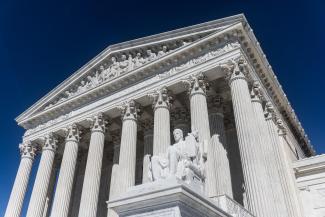Yesterday morning, the U.S. Supreme Court heard oral argument in a pair of cases—Loper Bright Enterprises v. Raimondo and Relentless, Inc. v. Department of Commerce—that by all accounts have the potential to result in a seismic shift in administrative and regulatory law, including changes for courts, the President and federal agencies, Congress, and the public.
The shift would result from changes to Chevron deference, an analytic framework courts have applied for the past 40 years when reviewing agency interpretations of their governing statutes. Justice John Paul Stevens announced the now-familiar two-step test in Chevron v. NRDC (1984), a case involving U.S. EPA’s interpretation of the phrase “stationary source” in the Clean Air Act:
First, always, is the question whether Congress has directly spoken to the precise question at issue. If the intent of Congress is clear, that is the end of the matter. . . . If, however, the court determines Congress has not directly addressed the precise question at issue, the court does not simply impose its own construction on the statute. . . . Rather, if the statute is silent or ambiguous with respect to the specific issue, the question for the court is whether the agency's answer is based on a permissible construction of the statute.
Stevens’ approach, which he noted was based on “well-settled” precedent, is premised on the idea that federal agencies, not courts, are best positioned to interpret the complex and, at times, technical words and phrases used in various statutory schemes. And there are a number of reasons why the Chevron test has proliferated and endured.

For starters, it acknowledges the reality that members of Congress often lack the time, technical knowledge, or political will to legislate in detail; nor can they always anticipate the path of complex issues or respond to every future development in real time.
Courts too have their own reasons for employing Chevron. Federal judges are generalists, tasked with a heavy caseload that covers wide swaths of federal and state law. While the Supreme Court gets to choose its own limited docket, other judges must grapple with the same complex issues using a fraction of the time and resources. Chevron deference lets them ensure that agencies are acting within their delegated authority, without having to second-guess “reasonable” interpretations of that authority.
A final reason for according due respect to agencies’ statutory interpretations is accountability. For all the rhetoric that often gets directed at “unelected bureaucrats,” the decisions of both political and career executive-branch employees remain subject to the presidential cycle, unlike decisions by unelected, lifetime appointees to the judicial branch.
However, the current Supreme Court majority may be poised to unsettle this balance in Loper Bright/Relentless. What started as a challenge to a 2020 Atlantic herring fishery management plan amendment, finalized by the National Marine Fisheries Services (an agency within NOAA, within the Department of Commerce), and requiring regulated vessels engaged in that fishery to pay for onboard third-party observers, has now morphed into the much more considerable question of Chevron’s future viability.
At least four justices voted to accept the cases, not to rule on the narrow question of whether NMFS exceeded its statutory authority under the Magnuson-Stevens Act, but rather petitioners’ preferred phrasing:
Whether the Court should overrule Chevron or at least clarify that statutory silence concerning controversial powers expressly but narrowly granted elsewhere in the statute does not constitute an ambiguity requiring deference to the agency.
Before oral argument, hinting at potential directions, several justices have recorded some level of discontent with Chevron. Justice Gorsuch has described it as “judicial abdication” and “fiction through and through.” Justice Thomas validated Chevron in 2005 but has since reversed course. While he was a judge on the D.C. Circuit, Justice Kavanaugh suggested Chevron would be better replaced with a “best reading” approach. Justice Alito as well. Chief Justice Roberts has voiced worries about “the administrative state,” but has also exhibited reservations about overruling long-standing precedent.
Initially scheduled for two hours, yesterday’s oral argument lasted nearly three and a half. The justices were divided primarily along ideological lines, with court watchers predicting that Chief Justice Roberts and Justice Barrett will cast the decisive votes. Questions from the Court’s newest member, Justice Jackson, however, went to the crux of the matter, and demonstrated the value of having the full bench of nine justices deciding such an important issue. “Worried about the courts becoming uber-legislators,” she probed where the interpretive line between policy and law could be drawn, suggesting that some questions of statutory interpretation are not purely legal and require policy determinations Congress intended for agencies, not courts, to resolve. Other justices raised questions about what happens to prior holdings already decided on Chevron grounds—an issue left unresolved at argument.
Predicting the Court’s decisions is always a fraught exercise, but given the path thus far, the justices appear poised to say something that will revise the well-known deference framework, rather than dispense with the cases on some other procedural ground. A decision that excises Chevron completely and replaces it with de novo review of agencies by individual judges would be a substantial departure from prior practice; while a decision limited to clarifying what judges should do when they conclude a law is “silent” might represent a more modest path though still a departure from Justice Stevens’ “well-settled,” “silent or ambiguous” formulation in Chevron.
The bottom line is that this case’s outcome could upend the status quo by reshaping the allocation of authority among governmental branches. Its outcome could provide the Court’s definitive word on who, agencies or judges, is better positioned to interpret and implement Congress’ statutes in the first instance, with impacts felt beyond the herring fishery, beyond environmental law, and into almost every area of life regulated by the federal government.
By the end of June, the Court will issue its decision.
